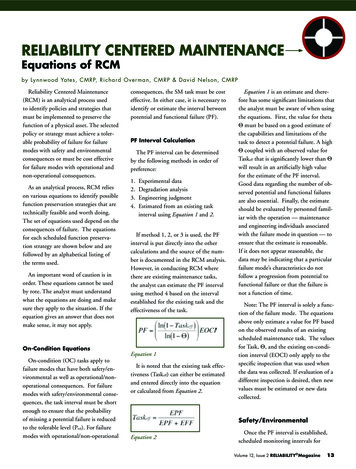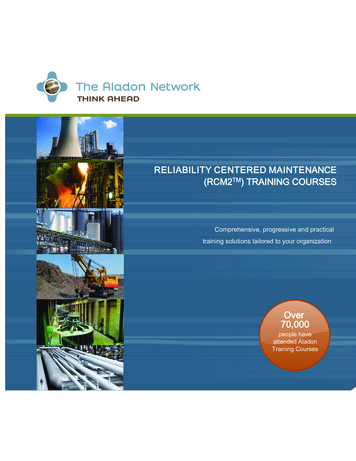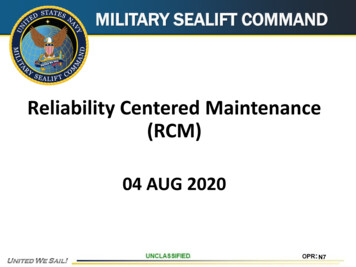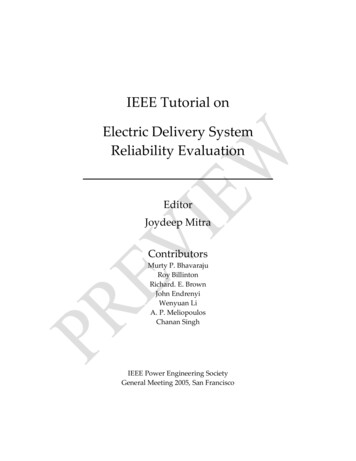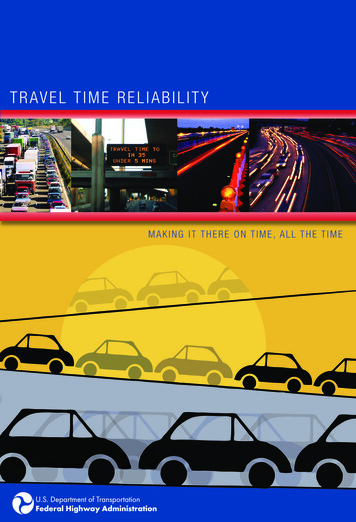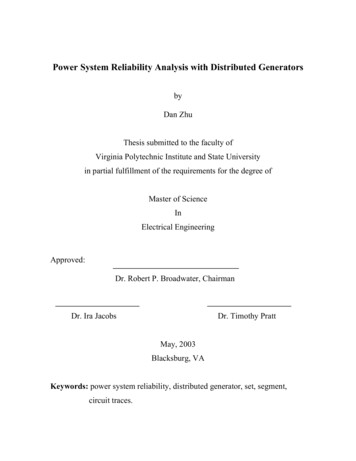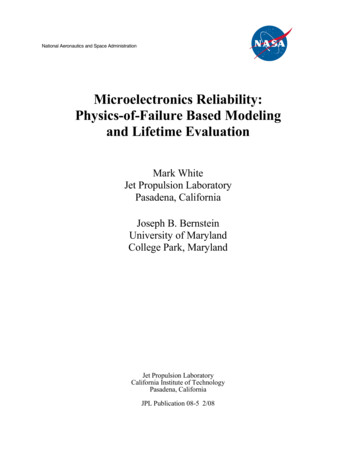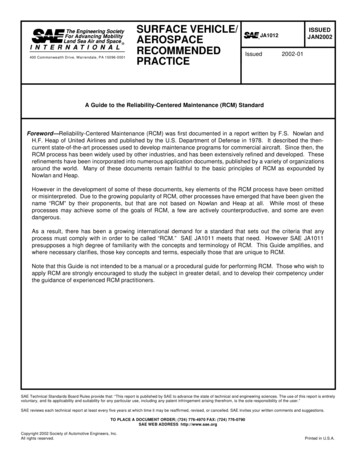
Transcription
400 Commonwealth Drive, Warrendale, PA 15096-0001SURFACE A1012Issued2002-01A Guide to the Reliability-Centered Maintenance (RCM) StandardForeword—Reliability-Centered Maintenance (RCM) was first documented in a report written by F.S. Nowlan andH.F. Heap of United Airlines and published by the U.S. Department of Defense in 1978. It described the thencurrent state-of-the-art processes used to develop maintenance programs for commercial aircraft. Since then, theRCM process has been widely used by other industries, and has been extensively refined and developed. Theserefinements have been incorporated into numerous application documents, published by a variety of organizationsaround the world. Many of these documents remain faithful to the basic principles of RCM as expounded byNowlan and Heap.However in the development of some of these documents, key elements of the RCM process have been omittedor misinterpreted. Due to the growing popularity of RCM, other processes have emerged that have been given thename “RCM” by their proponents, but that are not based on Nowlan and Heap at all. While most of theseprocesses may achieve some of the goals of RCM, a few are actively counterproductive, and some are evendangerous.As a result, there has been a growing international demand for a standard that sets out the criteria that anyprocess must comply with in order to be called “RCM.” SAE JA1011 meets that need. However SAE JA1011presupposes a high degree of familiarity with the concepts and terminology of RCM. This Guide amplifies, andwhere necessary clarifies, those key concepts and terms, especially those that are unique to RCM.Note that this Guide is not intended to be a manual or a procedural guide for performing RCM. Those who wish toapply RCM are strongly encouraged to study the subject in greater detail, and to develop their competency underthe guidance of experienced RCM practitioners.SAE Technical Standards Board Rules provide that: “This report is published by SAE to advance the state of technical and engineering sciences. The use of this report is entirelyvoluntary, and its applicability and suitability for any particular use, including any patent infringement arising therefrom, is the sole responsibility of the user.”SAE reviews each technical report at least every five years at which time it may be reaffirmed, revised, or cancelled. SAE invites your written comments and suggestions.TO PLACE A DOCUMENT ORDER; (724) 776-4970 FAX: (724) 776-0790SAE WEB ADDRESS http://www.sae.orgCopyright 2002 Society of Automotive Engineers, Inc.All rights reserved.Printed in U.S.A.
SAE JA1012 Issued JAN2002TABLE OF CONTENTS1.1.1Scope.4Organization of the Guide .42.2.12.22.3References .4Applicable Documents .4Related Publications . 4Other Publications .53.Definitions .54.Acronyms .75.Asset Definition .76.6.16.26.36.4Functions .8Operating Context .8List of Functions .9Describing Functions . 11Performance Standards. 117.7.17.2Functional Failures . 13Partial and Total Failure. 13Upper and Lower Limits. 148.8.18.28.38.48.5Failure Modes . 14Identifying Failure Modes .14Establishing What is Meant by “Reasonably Likely” . 15Levels of Causation . 16Sources of Information .18Types of Failure Modes . 189.9.19.2Failure Effects . 19Basic Assumptions . 19Information Needed . 1910.10.110.2Failure Consequence Categories .21Consequence Categories . 21Assessing Failure Consequences . 2511.11.111.211.311.4Failure Managmement Policy Selection . 25The Relationship between Age and Failure . 25Technically Feasible and Worth Doing . 26Cost Effectiveness . 26Failure Management Policy Selection .2612.12.112.212.312.4Failure Consequence Management . 26Evident Failure Modes with Safety or Environmental Consequences . 26Hidden Failure Modes with Safety or Environmental Consequences . 29Evident Failure Modes with Economic Consequences. 29Hidden Failure Modes with Economic Consequences.3013.Failure Management Policies—Scheduled Tasks . 30-2-
SAE JA1012 Issued JAN200213.113.213.313.4On-Condition Tasks . 30Scheduled Restoration and Scheduled Discard Tasks. 36Failure-Finding Tasks . 37Combination of Tasks . 4114.14.114.2Failure Management Policies—One-Time Changes and Run-to-Failure. 41One-Time Changes . 41Run to Failure . 4315.15.115.215.3Failure Management Policy Selection .43Two Approaches .43The Rigorous Approach. 44Decision Diagram Approaches . 4516.A Living Program . 5017.17.117.2Mathematical and Statistical Formulae . 50Logically Robust .51Available to Owner or rtant Additional Considerations .51Prioritizing Assets and Establishing Objectives .51Planning . 52Level of Analysis and Asset Boundaries . 52Technical Documentation . 53Organization . 53Training .53Role of Computer Software . 54Data Gathering . 54Implementation . 5419.19.1Notes .55Key Words . 55Figure 1Figure 2Figure 3Figure 4Figure 5Figure 6Figure 7Figure 8Figure 9Figure 10Figure 11Figure 12Figure 13Figure 14Figure 15Figure 16Figure 17Function of a pump . 11Allowing for deterioration .12Failure Modes of a Pump .15Failure Modes at Different Levels of Detail .17Evident Failure of a Protective Function . 22Hidden Failure of a Protective Function. 23Six patterns of failure. 25The P-F Curve . 31The P-F Interval . 31Net P-F Interval. 32Random failures and the P-F Interval. 33A linear P-F curve . 34Inconsistent P-F Intervals . 35Safe Life Limits . 37Failure-Finding Interval, Availability, and Reliability.39First Decision Diagram Example. 48Second Decision Diagram Example .49-3-
SAE JA1012 Issued JAN20021.Scope—SAE JA1012 (“A Guide to the Reliability-Centered Maintenance (RCM) Standard”) amplifies andclarifies each of the key criteria listed in SAE JA1011 (“Evaluation Criteria for RCM Processes”), andsummarizes additional issues that must be addressed in order to apply RCM successfully.1.1Organization of the Guide—Sections 5 to 14, 16, and 17 of this guide reflect the major sections of SAEJA1011. Section 15 explains in more detail how key elements of the RCM process can be combined to selectappropriate policies for managing individual failure modes and their consequences. Section 18 addressesmanagement and resourcing issues essential to the successful performance of RCM.2.References2.1Applicable Publications—The following publications form a part of this document to the extent specifiedherein. Unless otherwise indicated, the latest issue of SAE publications shall apply. The applicable issue ofother publications shall be the issue in effect on the date of the purchase order. In the event of conflictbetween the text of this document and references cited herein, the text of this document takes precedence.Nothing in this document, however, supersedes applicable laws and regulations unless a specific exemptionhas been obtained.2.1.1SAE PUBLICATION—Available from SAE, 400 Commonwealth Drive, Warrendale, PA 15096-0001.SAE JA1011—Evaluation Criteria for Reliability-Centered Maintenance (RCM) Processes2.22.2.1Related Publications—The following publications are provided for information purposes only and are not arequired part of this SAE Technical Report.U.S. D EPA RTMENT22161.OFCOMMERCE PUBLICA TION —Available from NTIS, Port Royal Road, Springfield, VANowlan, F. Stanley, and Howard F. Heap, “Reliability-Centered Maintenance,” Department of Defense,Washington, D.C. 1978, Report Number AD-A0665792.2.2U.S. D EPA RTMENT OF DEFE NSE PUBLICA TIONS—Available from DODSSP, Subscription Services Desk,Building 4/Section D, 700 Robbins Avenue, Philadelphia, PA 19111-5098.MIL-HDBK 2173(AS)—”Reliability-Centered Maintenance Requirements for Naval Aircraft, WeaponsSystems and Support Equipment,” (U.S. Naval Air Systems Command) (NOTE: canceled withoutreplacement, August 2001.)NAVAIR 00-25-403—”Guidelines for the Naval Aviation Reliability-Centered Maintenance Process,” (U.S.Naval Air Systems Command)MIL-P-24534—”Planned Maintenance System: Development of Maintenance Requirement Cards,Maintenance Index Pages, and Associated Documentation,” (U.S. Naval Sea Systems Command)2.2.3INDUSTRIAL PRE SS PUBLICATIO N—Available from Industrial Press, Inc., 200 Madison Avenue, New York City,New York, 10016 (also available from Butterworth-Heinemann, Linacre House, Jordan Hill, Oxford, GreatBritain OX2 8DP).Moubray, John, “Reliability-centered Maintenance,” 1997-4-
SAE JA1012 Issued JAN20022.2.4U.K. M INISTRY O F D EFENCE PUBLICATIO N—Available from Reliability-centred Maintenance ImplementationTeam, Ships Support Agency, Ministry of Defence (Navy), Room 22, Block K, Foxhill, Bath, BA1 5AB, UnitedKingdomNES 45—”Naval Engineering Standard 45, Requirements for the Application of Reliability-CentredMaintenance Techniques to HM Ships, Royal Fleet Auxiliaries and other Naval Auxiliary Vessels”(Restricted-Commercial)2.3Other Publications—The following publications were consulted in the course of developing this SAETechnical Report and are not a required part of this document.Anderson, Ronald T. and Neri, Lewis, “Reliability-Centered Maintenance: Management and EngineeringMethods,” Elsevier Applied Science, London and New York, 1990Andrews, J.D. and Moss, T.R., “Reliability and Risk Assessment,” Longman, Harlow, Essex (UK), 1993Blanchard, B.S., D. Verma and Peterson, E.L., “Maintainability: A Key to Effective Serviceability andMaintenance Management,” John Wiley and Sons, New York, 1995Cox, S.J. and Tait, N.R.S., “Reliability, Safety and Risk Management,” Butterworth Heinemann, Oxford,1991“Dependability Management - Part 3-11: Application guide - Reliability centred maintenance,” InternationalElectrotechnical Commission, Geneva, Doc. No. 56/651/FDISJones, Richard B., “Risk-Based Management: A Reliability-Centered Approach,” Gulf Publishing Co.,Houston, TX, 1995MSG-3, Maintenance Program Development Document,” Air Transport Association, Washington, D.C.Revision 2, 1993“Procedures for Performing a Failure Mode, Effects and Criticality Analysis,” Department of Defense,Washington, D.C. Military Standard MIL-STD-1629A, Notice 2, 1984“Reliability Centered Maintenance for Aircraft, Engines and Equipment,” United States Air Force,MIL-STD-1843. (NOTE: canceled without replacement, August 1995.)Smith, Anthony M., “Reliability Centered Maintenance,” McGraw-Hill, New York. 1993Zwingelstein, G., “Reliability Centered Maintenance, a practical guide for implementation,” Hermès, Paris.19963.Definitions3.1Age—A measure of exposure to stress computed from the moment an item or component enters service whennew or re-enters service after a task designed to restore its initial capability, and can be measured in terms ofcalendar time, running time, distance traveled, duty cycles or units of output or throughput.3.2Appropriate Task—A task that is both technically feasible and worth doing (applicable and effective).3.3Conditional Probability of Failure—The probability that a failure will occur in a specific period provided thatthe item concerned has survived to the beginning of that period.3.4Desired Performance—The level of performance desired by the owner or user of a physical asset or system.3.5Environmental Consequences—A failure mode or multiple failure has environmental consequences if itcould breach any corporate, municipal, regional, national or international environmental standard or regulationwhich applies to the physical asset or system under consideration.3.6Evident Failure—A failure mode whose effects become apparent to the operating crew under normalcircumstances if the failure mode occurs on its own.3.7Evident Function—A function whose failure on its own becomes apparent to the operating crew under normalcircumstances.-5-
SAE JA1012 Issued JAN20023.8Failure Consequences—The way(s) in which the effects of a failure mode or a multiple failure matter(evidence of failure, impact on safety, the environment, operational capability, direct and indirect repair costs).3.9Failure Effect—What happens when a failure mode occurs.3.10 Failure-finding Task—A scheduled task used to determine whether a specific hidden failure has occurred.3.11 Failure Management Policy—A generic term that encompasses on-condition tasks, scheduled restoration,scheduled discard, failure-finding, run-to-failure, and one-time changes.3.12 Failure Mode—A single event, which causes a functional failure.3.13 Function—What the owner or user of a physical asset or system wants it to do.3.14 Functional Failure—A state in which a physical asset or system is unable to perform a specific function to adesired level of performance.3.15 Hidden Failure—A failure mode whose effects do not become apparent to the operating crew under normalcircumstances if the failure mode occurs on its own.3.16 Hidden Function—A function whose failure on its own does not become apparent to the operating crew undernormal circumstances.3.17 Initial Capability—The level of performance that a physical asset or system is capable of achieving at themoment it enters service.3.18 Multiple Failure—An event that occurs if a protected function fails while its protective device or protectivesystem is in a failed state.3.19 Net P-F Interval— The minimum interval likely to elapse between the discovery of a potential failure and theoccurrence of the functional failure.3.20 Non-Operational Consequences—A category of failure consequences that do not adversely affect safety,the environment, or operations, but only require repair or replacement of any item(s) that may be affected bythe failure.3.21 On-Condition Task—A scheduled task used to detect a potential failure.3.22 One-Time Change—Any action taken to change the physical configuration of an asset or system (redesign ormodification), to change the method used by an operator or maintainer to perform a specific task, to changethe operating context of the system, or to change the capability of an operator or maintainer (training).3.23 Operating Context—The circumstances in which a physical asset or system is expected to operate.3.24 Operational Consequences—A category of failure consequences that adversely affect the operationalcapability of a physical asset or system (output, product quality, customer service, military capability, oroperating costs in addition to the cost of repair).3.25 Owner—A person or organization that may either suffer or be held accountable for the consequences of afailure mode by virtue of ownership of the asset or system.3.26 P-F Interval— The interval between the point at which a potential failure becomes detectable and the point atwhich it degrades into a functional failure (also known as “failure development period” and “lead time tofailure”).-6-
SAE JA1012 Issued JAN20023.27 Potential Failure—An identifiable condition that indicates that a functional failure is either about to occur or isin the process of occurring.3.28 Proactive Maintenance—Maintenance undertaken before a failure occurs, in order to prevent the item fromgetting into a failed state (scheduled restoration, scheduled discard, and on-condition maintenance).3.29 Protective Device or Protective System—A device or system which is intended to avoid, eliminate orminimize the consequences of failure of some other system.3.30 Primary Function(s)—The function(s) which constitute the main reason(s) why a physical asset or system isacquired by its owner or user.3.31 Run-To-Failure—A failure management policy that permits a specific failure mode to occur without anyattempt to anticipate or prevent it.3.32 Safety Consequences—A failure mode or multiple failure has safety consequences if it could injure or kill ahuman being.3.33 Scheduled—Performed at fixed, predetermined intervals, including “continuous monitoring” (where theinterval is effectively zero).3.34 Scheduled Discard—A scheduled task that entails discarding an item at or before a specified age limitregardless of its condition at the time.3.35 Scheduled Restoration—A scheduled task that restores the capability of an item at or before a specifiedinterval (age limit), regardless of its condition at the time, to a level that provides a tolerable probability ofsurvival to the end of another specified interval.3.36 Secondary Functions—Functions which a physical asset or system has to fulfill apart from its primaryfunction(s), such as those needed to fulfill regulatory requirements and those which concern issues such asprotection, control, containment, comfort, appearance, energy efficiency and structural integrity.3.37 User—A person or organization that operates an asset or system and may either suffer or be held accountablefor the consequences of a failure mode of that CMRPMUTIVE5.Built-In Test EquipmentFailure-finding (task) intervalFailure Mode and Effects AnalysisMillimetersMean Time Between Multiple FailuresMean Time Between FailuresMTBF of the Protected FunctionMTBF of the Protective FunctionPounds per Square InchReliability-Centered MaintenanceRevolutions Per MinuteAllowed Unavailability of the Protective FunctionAsset Definition—“RCM is a specific process used to identify the policies which must be implemented tomanage the failure modes which could cause the functional failure of any physical asset in a given operatingcontext.” (SAE JA1011, section 1.1)-7-
SAE JA1012 Issued JAN2002In order to identify appropriate failure management policies for any physical asset or system, the asset orsystem must be defined. This entails selecting the asset/system, defining its boundaries, and identifying themost appropriate level of detail at which to carry out the analysis.SAE JA1011 refers to the processes used to select suitable failure management policies, under theassumption that the asset/system concerned has already been selected and defined. It does not providecriteria for processes to be used for selecting and defining the assets or systems themselves, because suchprocesses tend to be highly dependent on the type of asset/system and where, for what, and by whom it isbeing (or to be) used. However some general guidance on this topic is provided in Section 18 of this guide.6.Functions—An RCM process that conforms to SAE JA1011 begins by asking the question, “What are thefunctions and associated desired standards of performance of the asset in its present operating context(functions)?” This section discusses the following four key concepts concerning functions that are listed inSection 5.1 of SAE JA1011:a.b.c.d.6.1Operating contextPrimary and secondary functionsFunction statementsPerformance standardsOperating Context—“The operating context of the asset shall be defined.” (SAE JA1011, section 5.1.1)The functions, failure modes, failure consequences, and failure management policies that will be applied to anyasset will depend not only on what the asset is, but also on the exact circumstances under which it is to beused. As a result, these circumstances need to be clearly defined before attempting to answer the questionquoted above.An operating context statement for a physical asset typically includes a brief overall description of how it is tobe used, where it is to be used, overall performance criteria governing issues such as output, throughput,safety, environmental integrity, and so on. Specific issues that should be documented in the operating contextstatement include:a.b.c.d.e.f.g.h.i.Batch versus flow processes: whether the asset is operating in a batch (or intermittent) process or aflow (or continuous) process.Quality standards: overall quality or customer service expectations, in terms of issues such as overallscrap rates, customer satisfaction measurements (such as on-time performance expectations intransportation systems, or rates of warranty claims for manufactured goods), or military preparedness.Environmental standards: what organizational, regional, national, and international environmentalstandards (if any) apply to the asset.Safety standards: whether any predetermined safety expectations (in terms of overall injury and/orfatality rates) apply to the asset.Theater of operations: characteristics of the location in which equipment is to be operated (arcticversus tropical, desert vs. jungle, on
Smith, Anthony M., “Reliability Centered Maintenance,” McGraw-Hill, New York. 1993 Zwingelstein, G., “Reliability Centered Maintenance, a practical guide for implementation,” Hermès, Paris. 1996 3. Definitions 3.1 Age—A measure of exposure to stress computed

